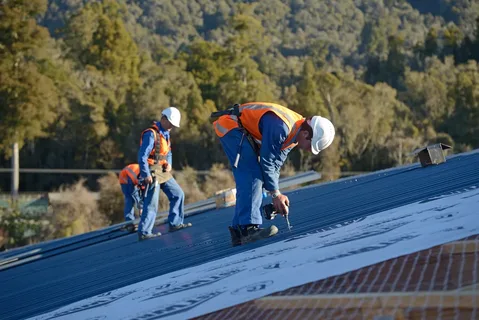Roofing is a crucial aspect of any structure, protecting buildings from environmental elements and enhancing their aesthetic appeal. Whether you own a commercial property or a residential home, choosing the right roofing shingles is essential for longevity, durability, and cost-effectiveness. While commercial and residential roofing share some similarities, they also have distinct differences that influence their functionality and performance. In this article, we will explore the key differences between commercial and residential roofing shingles to help you make an informed decision.
1. Material Composition
One of the primary differences between commercial and residential roofing shingles is the material used.
Commercial Roofing Shingles:
- Common materials include thermoplastic polyolefin (TPO), polyvinyl chloride (PVC), ethylene propylene diene terpolymer (EPDM), and metal roofing.
- These materials offer enhanced durability and are designed to withstand harsh weather conditions and high foot traffic.
- Flat or low-slope commercial roofs often utilize membrane roofing systems for improved water resistance.
Residential Roofing Shingles:
- The most commonly used materials are asphalt shingles, wood shakes, metal shingles, and composite shingles.
- Asphalt shingles dominate the residential market due to their affordability, ease of installation, and aesthetic versatility.
- Residential roofs typically have steeper slopes, making shingles a preferred choice for their durability and visual appeal.
2. Design and Aesthetics
The design and aesthetic preferences of commercial and residential roofing shingles differ significantly.
Commercial Roofing Design:
- Commercial buildings generally prioritize functionality over aesthetics.
- Flat or low-slope roofs with large surface areas require materials that provide superior water resistance and energy efficiency.
- Metal and single-ply membrane systems are common in commercial roofing due to their longevity and cost-effectiveness.
Residential Roofing Design:
- Residential roofing focuses on curb appeal and complements the home’s architectural style.
- Asphalt shingles, available in various colors and textures, allow homeowners to achieve the desired look.
- Wood shakes and slate shingles add a touch of elegance but come with higher maintenance requirements.
3. Installation Process
The installation techniques for commercial and residential roofing vary due to the complexity and scale of the projects.
Commercial Roofing Installation:
- Requires specialized equipment and expertise due to the larger surface area.
- Involves the use of roofing membranes, which may be installed using adhesives, mechanical fasteners, or heat welding.
- Takes longer to install due to the need for precision and durability.
Residential Roofing Installation:
- Simpler and quicker compared to commercial roofing.
- Asphalt shingles can be installed with roofing nails and adhesives, making the process less labor-intensive.
- Homeowners can expect a typical residential roof installation to be completed within a few days, depending on the weather and roof size.
4. Durability and Lifespan
Both commercial and residential roofing shingles are designed to last, but their durability and lifespan differ based on material and maintenance.
Commercial Roofing Durability:
- Designed to withstand heavy foot traffic, UV exposure, and extreme weather conditions.
- Materials like EPDM and TPO offer a lifespan of 20-30 years, while metal roofing can last 40-50 years with proper maintenance.
- Requires regular inspections and maintenance to prevent leaks and structural damage.
Residential Roofing Durability:
- Asphalt shingles typically last 20-30 years, while higher-end materials like slate or metal can exceed 50 years.
- Regular maintenance, including gutter cleaning and shingle replacement, extends the roof’s longevity.
- Less exposure to industrial pollutants and foot traffic contributes to a longer lifespan.
5. Cost Considerations
Cost plays a significant role in selecting roofing shingles, and the pricing varies for commercial and residential applications.
Commercial Roofing Costs:
- Higher upfront costs due to material durability, specialized installation, and labor-intensive procedures.
- Long-term cost savings due to energy-efficient roofing materials that reduce heating and cooling expenses.
- Maintenance costs vary based on the material used and the frequency of roof inspections.
Residential Roofing Costs:
- More affordable upfront costs, particularly for asphalt shingles.
- Higher-end materials like slate and metal come with a premium price tag but offer greater longevity.
- Lower maintenance costs, but occasional repairs and replacements may be necessary over time.
6. Maintenance Requirements
Both commercial and residential roofs require regular maintenance to ensure structural integrity and prevent costly repairs.
Commercial Roofing Maintenance:
- Regular inspections are essential due to the larger surface area and potential pooling of water.
- Roofing membranes may require periodic resealing to maintain waterproofing properties.
- Preventive maintenance helps extend the lifespan and prevent costly repairs.
Residential Roofing Maintenance:
- Requires periodic inspections for missing or damaged shingles.
- Gutter cleaning and debris removal help prevent water buildup and leaks.
- Minor repairs can often be handled by homeowners or local roofing professionals.
7. Energy Efficiency and Sustainability
Energy efficiency and sustainability are growing concerns in both commercial and residential roofing.
Commercial Roofing Efficiency:
- Many commercial buildings incorporate cool roofing technologies to reduce heat absorption and lower energy bills.
- Reflective roofing membranes like TPO and white EPDM improve insulation and contribute to sustainability efforts.
- Solar panel integration is more common in commercial roofing due to the large, flat surface area.
Residential Roofing Efficiency:
- Energy-efficient asphalt shingles with reflective granules help reduce cooling costs.
- Homeowners can install solar panels, but the steep slope may limit placement options.
- Sustainable roofing materials like metal and composite shingles are increasingly popular.
Conclusion
Understanding the key differences between commercial and residential roofing shingles is crucial when choosing the right option for your property. While commercial roofing prioritizes durability, functionality, and energy efficiency, residential roofing focuses on aesthetics, affordability, and ease of installation. By considering factors such as material composition, design, durability, cost, and maintenance, property owners can make an informed decision that aligns with their needs and budget. Whether you are a homeowner or a business owner, investing in the right roofing shingles will ensure long-term protection and value for your property.



